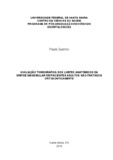| dc.creator | Guerino, Paula | |
| dc.date.accessioned | 2021-07-22T13:12:26Z | |
| dc.date.available | 2021-07-22T13:12:26Z | |
| dc.date.issued | 2016-07-13 | |
| dc.identifier.uri | http://repositorio.ufsm.br/handle/1/21560 | |
| dc.description.abstract | The aim of the study was to evaluate the bone limits in the region of the lower
incisors by Cone Beam volume CT (CBCT), and correlate with the pattern of facial
growth, with the inclination of the lower incisors, with the skeletal anteroposterior
relationship and the age of patients. Tomographic images of 40 patients
orthodontically untreated, have been imported into OsiriX Lite program (Pixmeo,
Geneva, Switzerland), which were held multiplanar reconstructions, resulting image
corresponding to the lateral teleradiography to determine the facial pattern, through
the Facial Height Index (FHI). Moreover, multiplanar reconstructions were made to
obtain sagittal sections in the region of the lower incisors. These images measured
alveolar bone thickness in buccal, lingual, full of the lower incisors, plus the thickness
measurements and total height of the mandibular symphysis. Measurements of
alveolar bone thickness buccal, lingual and total were obtained at level 20, 50, 80
and 100% of the root length of the lower incisors. The results of bone measurements
were correlated (Pearson correlation) with the facial pattern, with the inclination of the
lower incisors, with the skeletal anteroposterior relationship and the age of patients.
There were observed weak to moderate correlations among some bone
measurements with facial pattern, with the inclination of the incisors and the patient's
age. There was no association between the pattern of facial growth and the lingual
bone thickness in the lower incisors, and was not observed association between
bone measurements and skeletal anteroposterior relationship. It is believed that
patients with a tendency to long-face have lesser thickness of the alveolar process of
the lower incisors and greater height; patients already prone to short-face have, with
rare exceptions, higher labial bone thickness and overall the level of 50, 80 and
100% of the root length. | eng |
| dc.description.sponsorship | Coordenação de Aperfeiçoamento de Pessoal de Nível Superior - CAPES | por |
| dc.language | por | por |
| dc.publisher | Universidade Federal de Santa Maria | por |
| dc.rights | Attribution-NonCommercial-NoDerivatives 4.0 International | * |
| dc.rights.uri | http://creativecommons.org/licenses/by-nc-nd/4.0/ | * |
| dc.subject | Imagem tridimensional | por |
| dc.subject | Incisivo | por |
| dc.subject | Ortodontia | por |
| dc.subject | Processo alveolar | por |
| dc.subject | Tomografia computadorizada por Raios X | por |
| dc.subject | Alveolar process | eng |
| dc.subject | Imaging | eng |
| dc.subject | Three-dimensional | eng |
| dc.subject | Incisor | eng |
| dc.subject | Orthodontics | eng |
| dc.subject | Tomography | eng |
| dc.subject | X-ray computed | eng |
| dc.title | Avaliação tomográfica dos limites anatômicos da sínfise mandibular em pacientes adultos não-tratados ortodonticamente | por |
| dc.title.alternative | Tomographic evaluation of the anatomical limits of mandibular symphysis in orthodontically untreated adults | eng |
| dc.type | Dissertação | por |
| dc.description.resumo | O objetivo do estudo foi avaliar os limites ósseos na região dos incisivos inferiores,
através da tomografia computadorizada Cone Beam (TCCB), e correlacionar com o
padrão de crescimento facial, inclinação dos incisivos inferiores, relação
anteroposterior entre os maxilares e idade dos pacientes. As imagens tomográficas,
de 40 pacientes não tratados ortodonticamente, foram importadas para o programa
OsiriX Lite (Pixmeo, Geneva, Switzerland), onde foram realizadas reconstruções
multiplanares, obtendo imagem correspondente à telerradiografia lateral, para
determinação do padrão facial, através do Índice da Altura Facial (IAF). Além
disso, foram feitas reconstruções multiplanares, para obtenção de cortes sagitais da
região dos incisivos inferiores. Nestas imagens, foram mensuradas as espessuras
ósseas alveolares nas faces vestibular, lingual e total dos incisivos inferiores, além
das mensurações de espessura e altura total da sínfise mandibular. As medidas das
espessuras ósseas alveolares vestibular, lingual e total foram obtidas à nível de 20,
50, 80 e 100% do comprimento radicular dos incisivos inferiores. Os resultados das
medidas ósseas foram correlacionadas (Correlação de Pearson) com o padrão
facial, com a inclinação dos incisivos inferiores, com a relação entre os maxilares e
com a idade dos pacientes. Observou-se correlações fracas à moderadas entre
algumas medidas ósseas com padrão facial, com a inclinação dos incisivos e com a
idade do paciente. Não houve associação entre o tipo facial e as espessuras ósseas
linguais nos incisivos inferiores, assim como não foi observado associação entre as
medidas ósseas e a relação esquelética anteroposterior dos maxilares. Acredita-se
que pacientes com tendência à padrão de crescimento dolicofacial apresentam
menor espessura do processo alveolar dos incisivos inferiores e maior altura; já
pacientes com tendência à padrão de crescimento braquifacial apresentam, com
raras exceções, maiores espessuras ósseas vestibular e total à nível de 50, 80 e
100% do comprimento radicular. | por |
| dc.contributor.advisor1 | Ferrazzo, Vilmar Antonio | |
| dc.contributor.advisor1Lattes | http://lattes.cnpq.br/0267137255297190 | por |
| dc.contributor.referee1 | Grehs, Renésio Armindo | |
| dc.contributor.referee2 | Farret, Marcel Marchiori | |
| dc.creator.Lattes | http://lattes.cnpq.br/4288079249947753 | por |
| dc.publisher.country | Brasil | por |
| dc.publisher.department | Odontologia | por |
| dc.publisher.initials | UFSM | por |
| dc.publisher.program | Programa de Pós-Graduação em Ciências Odontológicas | por |
| dc.subject.cnpq | CNPQ::CIENCIAS DA SAUDE::ODONTOLOGIA | por |
| dc.publisher.unidade | Centro de Ciências da Saúde | por |



